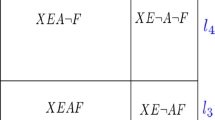Abstract
mathematical formalism for subjective modeling, based on modelling of uncertainty, reflecting unreliability of subjective information and fuzziness that is common for its content. The model of subjective judgments on values of an unknown parameter x ∈ X of the model M(x) of a research object is defined by the researcher–modeler as a space1 (X, p(X), \(P{I^{\bar x}}\), \(Be{l^{\bar x}}\)) with plausibility\(P{I^{\bar x}}\) and believability \(Be{l^{\bar x}}\) measures, where x is an uncertain element taking values in X that models researcher—modeler’s uncertain propositions about an unknown x ∈ X, measures \(P{I^{\bar x}}\), \(Be{l^{\bar x}}\) model modalities of a researcher–modeler’s subjective judgments on the validity of each x ∈ X: the value of \(P{I^{\bar x}}(\tilde x = x)\) determines how relatively plausible, in his opinion, the equality \((\tilde x = x)\) is, while the value of \(Be{l^{\bar x}}(\tilde x = x)\) determines how the inequality \((\tilde x = x)\) should be relatively believed in. Versions of plausibility Pl and believability Bel measures and pl- and bel-integrals that inherit some traits of probabilities, psychophysics and take into account interests of researcher–modeler groups are considered. It is shown that the mathematical formalism of subjective modeling, unlike “standard” mathematical modeling, •enables a researcher–modeler to model both precise formalized knowledge and non-formalized unreliable knowledge, from complete ignorance to precise knowledge of the model of a research object, to calculate relative plausibilities and believabilities of any features of a research object that are specified by its subjective model \(M(\tilde x)\), and if the data on observations of a research object is available, then it: •enables him to estimate the adequacy of subjective model to the research objective, to correct it by combining subjective ideas and the observation data after testing their consistency, and, finally, to empirically recover the model of a research object.
Similar content being viewed by others
References
Yu. P. Pyt’ev, Moscow Univ. Phys. Bull. 72, 1 (2017). https://doi.org/10.3103/S002713491701012X
Yu. P. Pyt’ev, Math. Models Comput. Simul. 5, 538 (2013). doi doi 10.1134/S2070048213060094
Yu. P. Pyt’ev, Possibility as an Alternative to Probability, 2nd ed. (Fizmatlit, Moscow, 2016).
Yu. P. Pyt’ev, Intellekt. Sist. 11, 277 (2007).
A. L. Tulup’ev, S. I. Nikolenko, and A. V. Sirotkin, Bayesian Networks: A Logical–Probabilistic Approach (Nauka, St. Petersburg, 2000).
A. Jøsang and R. Hankin, in Proc. 15th International Conference on Information Fusion, Singapore, 2012. https://pdfs.semanticscholar. org/1189/3bcadf7582e1c96e72ccf75aa0ef41a72 e88.pdf.
A. M. Mironov, Intellekt. Sist. 11, 201 (2007).
Applied Fuzzy Systems, Ed. by T. Terano, K. Asai, and M. Sugeno (Elsevier, 1989).
Fuzzy Set and Possibility Theory. Recent Developments, Ed. by R. R. Yager (Pergamon, New York, 1982).
D. A. Balakin, Yu. M. Nagornyi, and Yu. P. Pyt’ev, in Proc. Int. Conf. “Infinite-Dimensional Analysis, Stochastics, and Mathematical Modeling: New Problems and Methods,” Moscow, Russia, 2014, p. 190.
V. Bhavsar and A. M. Mironov, in Proc. Workshop on Multivalued Logic Programming and Applications, Seattle, United States, 2006, p. 73.
R. G. Cowell, A. P. Dawid, S. L. Lauritzen, and D. J. Spiegelhalter, Probabilistic Networks and Expert Systems: Exact Computational Methods for Bayesian Networks (Springer, New York, 1999).
G. Shafer, A Mathematical Theory of Evidence (Princeton Univ. Press, 1976).
A. Jøsang, in Proc. 11th Workshop on Preferences and Soft Constraints, Perugia, Italy, 2011. http://home.ifi.uio.no/josang/papers/Jos2011- SofT.pdf.
S. S. Stevens, Psychophysics (Wiley, New York, 1975).
A. A. Jøsang, Int. J. Unc. Fuzz. Knowl. Based Syst. 09, 279 (2001).
G. J. Klir, Uncertainty and Information: Foundations of Generalized Information Theory (Wiley, 2006).
E. T. Jaynes, IEEE Trans. Syst. Sci. Cybern. 4, 227 (1998).
H. Jeffreys, Proc. R. Soc. London A 186, 453 (1946).
L. Zadeh, AI Mag. 7 (2), 85 (1986).
P. Wang, in Proc. 10th Conf. on Uncertainty in Artifical Intelligence, Seattle, United States, 1994, p. 560.
R. R. Yager, Inf. Sci. 41 (2), 93 (1987).
T. Inagaki, IEEE Trans. Reliab. 40, 182 (1991).
D. Dubois and H. Prade, in Reliability Data Collection and Analysis, Ed. by J. Flamm and T. Luisi (Springer, 1992), p. 213.
F. Smarandache, Int. J. Appl. Math. Stat. 2, 1 (2004).
M. A. Kłopotek and S. T. Wierzchoń, in Belief Functions in Business Decisions, Ed. by R. P. Srivastava and T. J. Mock (Springer, 2002), p. 62.
D. A. Balakin, B. I. Volkov, T. G. Elenina, A. S. Kuznetsov, and Yu. P. Pyt’ev, Intellekt. Sist. 18 (2), 33 (2014).
B. MacMillan, Ann. Math. Stat. 24, 196 (1953).
Yu. P. Pyt’ev and I. A. Shishmarev, Probability Theory, Mathematical Statistics, and Elements of Possibility Theory for Physicists (Mosk. Gos. Univ., Moscow, 2010).
D. Dubois, H. T. Nguyen, and H. Prade, in Fundamentals of Fuzzy Sets, Ed. by D. Dubois and H. Prade (Kluwer Academic, Boston, 2000), p. 343.
S. Guiasu, Information Theory with Applications (McGraw-Hill, New York, 1977).
Yu. P. Pyt’ev and G. S. Zhivotnikov, Intellekt. Sist. 6 (1–4), 63 (2002).
R. R. Yager, Fuzzy Sets Syst. 50, 279 (1992).
H. E. Kyburg, Jr., and H. E. Smokler, Studies in Subjective Probability (Wiley, New York, 1964).
L. J. Savage, The Foundations of Statistics (Dover, New York, 1972).
Yu. P. Pyt’ev, Pattern Recognit. Image Anal., 27, 213 (2017), doi doi 10.1134/S1054661817020080
J. Y. Halpern, Reasoning about Uncertainty (MIT Press, Cambridge, 2003).
Yu. P. Pyt’ev, Moscow Univ. Phys. Bull. 72, 113 (2017). https://doi.org/10.3103/S0027134917010131
Yu. P. Pyt’ev, Possibility. Elements of Theory and Applications (Editorial URSS, Moscow, 2000).
Author information
Authors and Affiliations
Corresponding author
Additional information
Original Russian Text © Yu.P. Pyt’ev, 2018, published in Vestnik Moskovskogo Universiteta, Seriya 3: Fizika, Astronomiya, 2018, No. 1, pp. 3–17.
About this article
Cite this article
Pyt’ev, Y.P. Mathematical Methods of Subjective Modeling in Scientific Research: I. The Mathematical and Empirical Basis. Moscow Univ. Phys. 73, 1–16 (2018). https://doi.org/10.3103/S0027134918010125
Received:
Accepted:
Published:
Issue Date:
DOI: https://doi.org/10.3103/S0027134918010125




